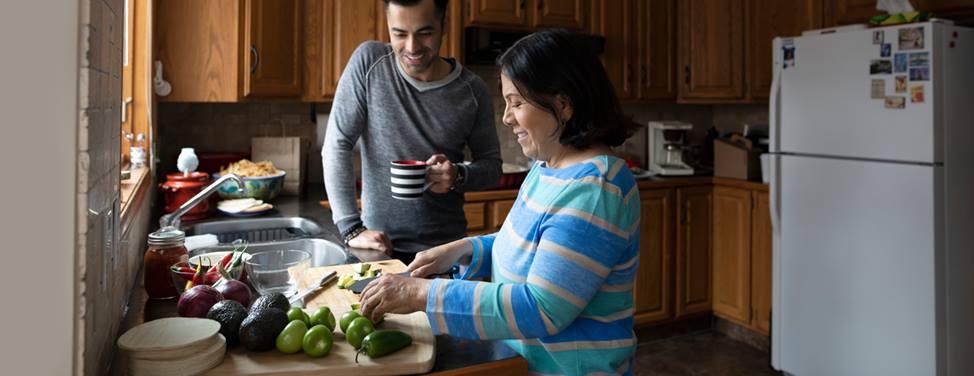
Diet for Cancer Treatment Side Effects
Nausea
Nausea is a common side effect of chemotherapy and radiation therapy. It may be due to the treatment or the cancer itself. If you experience it after surgery, be sure to discuss this with your doctor or medical team.
Here are some practical tips to help with nausea:
- Eat meals slowly.
- Eat small portions of food frequently. Having some food in your stomach may help you feel better.
- Low-fat, bland and salty foods usually work best. Avoid greasy, fried and strongly spiced foods.
- Cool, clear beverages are recommended. Drink liquids between meals, rather than with meals. Slowly drink or sip liquids throughout the day – a straw may help.
- Don't force yourself to eat your favorite foods when you feel nauseated, as you may develop a dislike for these foods.
- Stay quiet after meals. Try to rest while sitting up for about an hour – you can watch television, read a magazine, talk with a loved one or enjoy the company of your pet. Do not lie flat for at least two hours after eating.
- Keep crackers at your bedside if nausea is a problem in the morning or after a nap.
- Stay away from odors. Have someone else cook if possible. Eat in the dining room or in a room other than the kitchen.
- If the smell of food makes you nauseated, avoid hot foods and liquids. Try colder foods and main-dish salads.
- Track your nausea by taking note of any particular food or events that trigger it. See if there is a pattern and if so, try to change that pattern.
- Inform your nurse or doctor about your nausea and ask about medications to control this side effect.
Suggested foods
- Cream of wheat, oatmeal and cold cereal
- Soups
- Cold sandwiches
- Cottage cheese
- Hard boiled eggs
- Plain pasta, rice, noodles and mashed potatoes
- Toast, dry Saltine-style crackers, natural potato chips or pretzels
- Canned fruit, applesauce and Jell-O
- Custard and pudding
- Sherbet, popsicles and frozen fruit bars
- Soda, juice and herbal tea
- Low-fat protein sources such as skinned chicken or tofu that is baked or broiled, not fried
- Peaches or other soft, mild-tasting fruits and vegetables
- Clear liquids such as apple and cranberry juice, low-salt broth and carbonated drinks without caffeine
- Teas such as ginger and peppermint, served lukewarm or cold
Vomiting
Vomiting may follow nausea and be brought on by treatment or food odors. If vomiting is severe or lasts for more than a day or two, contact your doctor. Visualization and relaxation exercises may help. Here are some other tips:
- Do not eat or drink anything until you have the vomiting under control.
- Try tiny amounts of clear liquids such as water or bouillon, apple or cranberry juice, fruit ices without fruit pieces, ginger ale or 7-Up, plain gelatin desserts, popsicles, sports drinks such as Gatorade, vegetable broth and teas.
- Begin with 1 teaspoon every 10 minutes, gradually increasing the amount to 1 tablespoon every 20 minutes, and then try 2 tablespoons every 30 minutes or as tolerated.
- Once these liquids are tolerated, try a softer diet with bland foods such as mashed potatoes, rice, pureed fruits, smoothies, fruit nectars, yogurts and cereals with milk or soy if you have problems with digesting milk.
- Drink and eat more potassium- and magnesium-rich foods when feeling better. Potassium-rich foods include bananas, potatoes, orange juice, tomato and apricots.
Constipation
Chemotherapy, certain medications, or lack of exercise may cause constipation. Adding more fiber to your diet may help. Here are some easy ways to add fiber to your diet and to help constipation.
- Try including high-fiber foods – such as kidney beans, chickpeas, lentils, fresh fruit and vegetables and dried fruit – to your diet. Try to include some fiber in each of your meals.
- Start your day eating bran cereals or shredded wheat, or foods made with whole grains such as bulgur or wheat berries. Aim for a cereal with at least 5 grams of fiber per serving.
- Add unprocessed wheat bran to hot cereals and yogurt.
- If you're not used to eating a lot of fiber, slowly increase your intake, as you may initially have increased flatulence (gas) until your body gets used to more fiber in the diet.
- You can also reduce flatulence from eating beans by soaking beans first in water and discarding the water.
- Drink plenty of liquids – eight to 10 glasses each day. A high-fiber diet requires plenty of fluids to work effectively.
- Reduce your caffeine intake, as caffeine may promote constipation by causing you to lose fluids.
- Drink a hot, non-caffeinated beverage such as lemon water in the morning upon awakening.
- Add exercise to your daily routine. Check with your doctor first.
Suggested foods
- Whole grain breads and pastas, bran cereals
- Cooked beans, peas and lentils
- Raw fruits and vegetables
- Dried fruit
- Prune juice and hot lemon water
Diarrhea
Diarrhea can have many causes. You may get it because of chemotherapy, radiation therapy to the lower abdomen, malabsorption, or use of antibiotics. It can also develop because of intolerance to milk or difficulty in absorbing fats. If you experience weight loss from diarrhea, it may be due to dehydration, which means that your body does not have enough water. Speak with your health professional to try to determine the cause of the weight loss and obtain the proper treatment.
If you have diarrhea:
- Drink plenty of room-temperature liquids to help prevent dehydration. These might include water, teas, Gatorade, ginger ale, peach or apricot nectar or fruit juices. Limit caffeinated beverages.
- Allow carbonated beverages to lose their fizz or stir them before you drink them.
- Consume more potassium-rich foods such as orange juice, tomato juice, bananas and potatoes.
- Try the BRAT diet, which consists of bananas, rice, applesauce, tea and toast.
- Try frequent, small meals.
- Avoid fried, greasy foods. Have spicy or highly seasoned foods only as tolerated.
- Cut down on high-fiber foods such as whole grains, bran cereals and vegetables.
- Try breads made from oat flour or refined flour without seeds or nuts.
- Avoid raw vegetables and the skins, seeds, and stringy fibers of unpeeled fruits.
- Resume your consumption of higher fiber foods, fruits and vegetables once the diarrhea stops (check with your dietitian and doctor first).
- If you are lactose intolerant, use dairy products sparingly. Instead of regular milk, try Lactaid, yogurt or soy milk.
- The use of probiotics, l-glutamine, and/or digestive enzymes may help to improve symptoms. Please discuss the use of these supplements with a dietitian to determine if these products are appropriate and which brands you may wish to choose.
- Avoid milk, ice cream and puddings for now since they can upset your stomach. Yogurt, sherbet, cheese and custard may be tolerated since these foods contain smaller amounts of lactose.
Suggested foods
- Cream of wheat, oatmeal and plain rice and corn cereals
- Canned fruits, nectars and applesauce
- White rice, pasta and potatoes without skin
- Sandwiches on white bread
- Soups without cream
- Cheese and crackers, graham crackers and peanut butter
- Eggs
- Jell-O and popsicles
- Soda and herbal tea
- Nutritional drinks like Ensure, Resource, Sustacal, Pediasure and Boost
Loss of Appetite
Problems such as pain, nausea, vomiting, diarrhea or a sore or dry mouth may make eating difficult and cause you to lose interest in eating. Depression, stress, and anxiety may also cause loss of appetite. If your appetite is no longer motivating you to eat, here are some suggestions to help ensure that you are getting the nutrition that you need.
- Eat three small meals and three snacks per day. Eat by the clock rather than by your hunger mechanism – at 9 a.m., noon, 3 p.m., 6 p.m. or whatever your daily pattern becomes.
- Choose high-calorie foods at this time, such as avocados, nuts, seeds, puddings, cooked cereals, dried fruits and vegetables dipped in hummus or prepared with olive oil. Use additional olive oil in salads.
- Snack between meals. Choose fruit smoothies, high-calorie puddings, shakes, high-calorie and protein drink supplements, sandwiches, avocados and nuts. Also, keep snacks by your bedside.
- Plan for special circumstances. If you have to miss or delay a meal for a test or therapy, bring a snack of nuts, dried fruit or cheese and crackers. Ask your dietitian if these foods fit into your medical diet.
- Plan your daily menu in advance. Make a shopping list of your favorite foods and beverages and have the food available. You may want to portion out snacks and keep them in the refrigerator in Ziploc bags so that they are readily available.
- Request help in preparing your meals. A friend or relative is often happy to help out by preparing food for you. Some grocery stores have shopping services that may be accessed through your computer. You are very important – ask for help when you need it, and ideally before you anticipate that you will need it.
- Fix several portions of your favorite foods and freeze them. This can make it easier to decide what to eat when your appetite is poor or you do not feel like cooking.
- Make food visually appealing. Eye appeal is often the first step in eating. Attractive colors and garnishes such as parsley, lemon wedges, olives and cherry tomatoes help enliven the appetite.
- Appeal to your sense of smell. Tap into the sense of well-being that smells can stimulate, such as the smell of fresh bread baking. If, however, you find that you are overwhelmed by smells at this time, stay away from the kitchen, and have someone else prepare the cooking.
- Make your mealtimes pleasant. Your mealtime atmosphere is important to encourage eating. Set the table, perhaps adding candles, as well as wine, if permitted. Whenever possible, eat with family or friends.
- If you are finding it difficult to cook due to the symptoms of chemotherapy, consider calling organizations such as Project Open Hand at (415) 447-2300 or Meals on Wheels at (415) 920-1111 that deliver meals directly to your house.
- Try milkshakes or supplements such as Ensure Carnation Instant Breakfast, when you do not feel like eating.
Mouth Sores, Chewing or Swallowing Difficulties
Soreness and tenderness in the mouth and throat are not uncommon. If your swallowing difficulties are minor, the following suggestions may help. You may need to work with a dietitian or swallowing therapist or consider alternative methods of feeding if you have severe problems.
- Eat frequent small meals and snacks to ensure that you are getting enough calories. Choose cool, smooth and bland foods. Soft solids and liquids work best.
- Cut foods into bite-sized pieces or grind them so that less chewing is required.
- Choose soft foods or foods that can be cooked until tender such as mashed potatoes, sweet potatoes, winter squashes (butternut and acorn), carrots, applesauce, ground beef or turkey and tofu.
- Consume liquid supplements such as Prosure, Ensure Plus, Boost Plus or shakes that can be made in your blender.
- Consider using a blender to puree the foods your family is eating. When adding liquid to process the foods, remember to add high-calorie liquids – such as gravy, milk or soy milk, or broth – instead of water.
- Drink generous amounts of nutritious liquids with meals.
- Be adventurous. Try new sauces, gravies, or different oils on foods to make swallowing easier.
- Try apple, cranberry, or grape juices or fruit nectars if you are sensitive to citrus juices.
- Keep some baby food on hand for something quick and tasty.
- Try drinking liquids through a straw or as recommended by your swallowing therapist.
- Avoid spicy, salty and acidic foods and beverages.
Suggested foods
- Nectars and apple juice
- Canned fruit and applesauce
- Cream of wheat
- Potato soup, chicken noodle soup and rice soup (juk)
- Custard, puddings, yogurt and Jell-O
- Popsicles, ice cream and sherbet
- Milkshakes and Carnation Instant Breakfast
- Nutritional drinks like Ensure, Resource, Sustacal, Pediasure and Boost
Taste and Smell Changes
- Avoid red meats if they taste metallic. Eat more chicken, turkey, dairy products and casseroles.
- When foods have less taste, try tart foods such as yogurt, lemon or orange Jell-O, or lemonade.
- When foods taste or smell funny try cold or room temperature foods.
- Try marinated or spicy foods such as enchiladas, herbed chicken or spaghetti if you do not have nausea, vomiting or mouth sores.
- Use hard candies to take away bad taste between meals.
- Maintain good oral hygiene.
Please also see our patient education article, Nutrition and Coping With Cancer Symptoms.
UCSF Health medical specialists have reviewed this information. It is for educational purposes only and is not intended to replace the advice of your doctor or other health care provider. We encourage you to discuss any questions or concerns you may have with your provider.


























